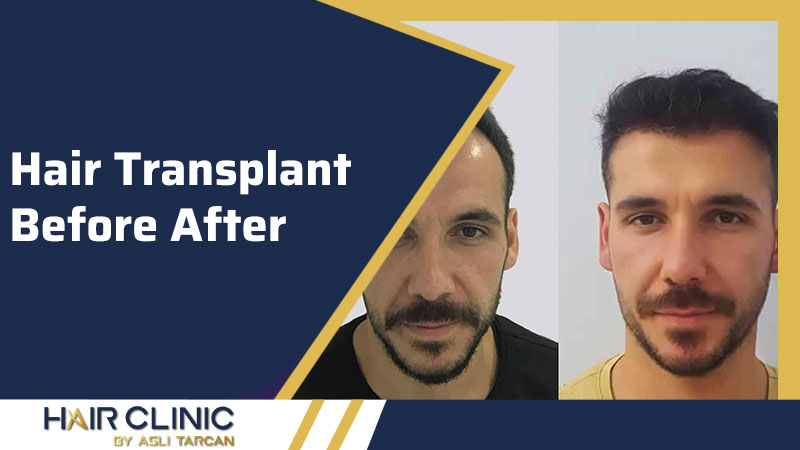Hair Transplant Before After Also called hair restoration or hair implant; hair transplant is an aesthetic procedure that involves taking hair from one or more areas of your body – usually the back or sides of your scalp, or even your beard, back, or chest – and move them to a recipient area where you have hair loss. You can decide to have a hair transplant by looking at the hair transplant before after photos.
Healthy hair follicles are transplanted as “grafts”, each containing one to four hairs per piece. A 2,500 graft process, for example, can contain about 5,000 individual hairs.
Hair transplants were once performed almost exclusively on the scalp and this is still the most common procedure. However, hair restoration surgeons are now doing beard and eyebrow transplants.
According to the American Academy of Dermatology, more than 80 million men and women experience hair loss. It is normal to lose 50-100 hairs a day, but bald spots, a thin section, and a receding hairline may indicate a bigger problem.
Usually, the cause is genetic a type of hair loss known as androgenic alopecia. Also called male and female baldness, it usually begins in men as a receding hairline or thinning in the crown, while women usually experience recession near the temples and an enlarged line. Fortunately, a hair transplant can usually make up for a lost time (provided the hair loss is not very advanced).
Hair transplant before after
What are the pros and cons of a hair transplant?
Advantages
- When hair is transplanted properly, it grows for the rest of your life.
- Very little preparation is required.
- Hair transplants can look extremely natural when done well.
- Most patients do not need pain medication later, especially with the FUE (follicular unit extraction) technique.
Disadvantages
- Hair transplantation does not stop the progression of hair loss on the scalp. Patients may need to undergo other procedures in other areas if the prophylaxis is not taken or works well.
- When surgery goes wrong, hair can look unnatural or just bad, due to poor design and technique.
- If not performed properly, a hair transplant can damage the surrounding hairs.
- Not all hair transplants will survive.
- Depending on the type of hair transplant, there may be slight scarring.
- Hair transplantation is an expensive procedure that is usually not covered by insurance.
Who Is A Good Candidate For Hair Transplant Surgery?
The best candidates will be 20 years old or older. When you are in your 20s, it is difficult to know how much more hair you will lose in the future. Younger patients tend to have unrealistic expectations. Most elderly patients already show signs of baldness in men or women, making it easier for hair transplant surgeons to predict future hair loss and create a hairline that looks natural over time.
You will also need enough healthy donor hair for the surgeon to get it. If your scalp is thinning or you already have significant hair loss, you may not have a healthy enough donor site for a successful hair transplant procedure.
In general, hair transplant surgery is more common in men. A study by hair restoration experts found that the procedure is performed on men 85.7% of the time. The numbers were a little closer for hair restoration surgeries, with respondents treating men 61.8% of the time, compared to women at 38.2%.
How long does it take to restore a hair transplant?
Recovery is usually a piece of cake, especially in the donor area where the implants were removed, which will heal completely in three days.
You may experience mild tenderness and swelling on the scalp, along with some wear and crust for six to seven days where the hairs were implanted. If a follicular unit is removed, the donor area at the back of the head will heal substantially and will not be felt for 7-10 days.
For the first five days, you should follow a gentle approach when washing your hair. Use a mild shampoo, without harsh detergents and do not rub aggressively (you do not want to peel an implant). After that, it is safe to continue the usual hair washing habits. You can also start exercising again five to seven days after the transplant.
Is It Safe To Have Hair Transplant Surgery?
With an experienced surgeon, hair transplants involve minimal risks. Tell your surgeon that you want to see photos of previous patients hair transplant before after. Minor side effects such as bleeding, itching, swelling and crusting when the hair is moved or implanted usually clear up in a few weeks. Some patients may develop an infection or inflammation called bursitis, so talk to your surgeon about how to gently cleanse your scalp.
“Shock loss” of transplanted hair is common and usually temporary, before new hair grows. However, a hair transplant that is not performed properly can damage the surrounding hair follicles, leading to tufts and patches. Some scars are also possible.
What are some alternatives to hair transplant surgery?
There are many non-surgical options for hair loss, although none offer the permanent non-maintenance of a hair transplant. However, if you want to avoid surgery (or the high cost), here are some other ways to help regenerate thinning hair.
Platelet Rich (PRP) This treatment uses injections of your blood platelets, full of growth factors and proteins, to stimulate new hair growth. It works in about 60% of patients and must be repeated every four to six months (or more often with some PRP systems) to maintain results.
Low Level Laser Therapy (LLLT) You will need to use them several times a week to stimulate hair growth and it will take six months for them to work – plus you will need to continue using them to maintain the results .
Scalp Micropigmentation (SMP) In this procedure, tiny tattoo dots are placed between the hairs on your scalp, so the hair looks thicker and you will see less visible scalp.
Propecia This daily prescription pill cures male pattern baldness by reducing DHT, a male hormone that plays a role in hair loss. The drug can also be prescribed to menopausal women. It takes up to three months to make a difference and you should continue to take it to maintain the new hair you have grown.
Rogaine This topical treatment contains minoxidil, which lifts the follicles and prolongs the hair growth phase. You should see a 25% improvement in three months or more with continued use. Like the other treatments we have mentioned, once you stop using them, you will lose any gains.
To decide on a hair transplant, you can look at hair transplant before after photos. You can have a successful hair transplant treatment with our clinic’s experienced doctors. Contact our clinic today to get the look you want.



